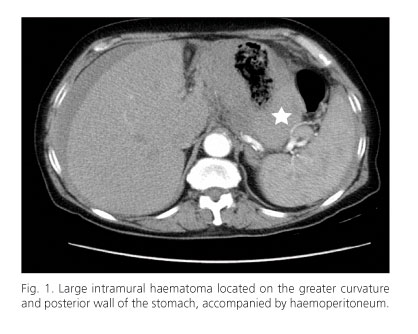Mi SciELO
Servicios Personalizados
Revista
Articulo
Indicadores
-
 Citado por SciELO
Citado por SciELO -
 Accesos
Accesos
Links relacionados
-
 Citado por Google
Citado por Google -
 Similares en
SciELO
Similares en
SciELO -
 Similares en Google
Similares en Google
Compartir
Revista Española de Enfermedades Digestivas
versión impresa ISSN 1130-0108
Rev. esp. enferm. dig. vol.103 no.9 Madrid sep. 2011
https://dx.doi.org/10.4321/S1130-01082011000900013
LETTERS TO THE EDITOR
Spontaneous intramural gastric haematoma in an anticoagulated patient
Hematoma gástrico intramural espontáneo en paciente anticoagulada
Key words: Gastric hematoma. Acenocumarol.
Palabras clave: Hematoma gástrico. Acenocumarol.
Dear Editor,
We report a case of a 77-year-old woman presented to the Emergency Unit with a history of several hours of epigastric pain accompanied by nausea and vomiting. She had a past medical history of rheumatic mitral valve disease with commissurotomy in 1982 and permanent atrial fibrillation, currently on anticoagulation therapy with acenocoumarol. On admission, the patient was in atrial fibrillation at 50 beats per minute and her blood pressure was 90/55 mmHg. Laboratory tests showed haemoglobin 10.2 g/dL, INR 2.31 and markers of myocardial damage were normal. A computed tomography (CT) of the chest and abdomen was performed, revealing the presence of a large intramural haematoma located on the greater curvature and posterior wall of the stomach, measuring 13 x 10 x 6 cm, accompanied by haemoperitoneum (Fig. 1). Vitamin K and prothrombin complex were given to reverse the anticoagulant therapy with a good result, and the patient did not require blood transfusion.
Discussion
Gastric wall haematoma is a very rare entity, usually associated with coagulopathy, ulcer, trauma or amyloid angiopathy. CT is the investigation of choice for the diagnosis of gastro-intestinal wall haematoma, and angiography may play a role at a therapeutic level. Only one of the five cases of gastric haematoma associated with anticoagulant therapy published in the literature (1-5) required arterial embolization due to angiographic evidence of active bleeding (2). Conservative management is more common, with blood transfusion and anticoagulation reversal.
Ana Isabel Hurtado Doce, Miguel Antonio Solla Buceta and Rita María Galeiras Vázquez
Department of Intensive Care Medicine. Complejo Hospitalario Universitario A Coruña. A Coruña, Spain
References 1. Dhawan V, Mohammed A, Fedorak RN. Gastric intramural hematoma: a case report and literature review. Can J Gastroenterol 2009; 23:19-22. [ Links ] 2. Imaizumi H, Mitsuhashi T, Hirata M, et al. A giant intramural gastric hematoma successfully treated by transcatheter arterial embolization. Intern Med 2000;39:231-4. [ Links ] 3. Balthazar EJ, Einhorn R. Intramural gastrointestinal hemorrhage. Clinical and radiographic manifestations. Gastrointest Radiol 1976;3: 229-39. [ Links ] 4. Durward QJ, Cohen MM, Naiman SC. Intramural hematoma of the gastric cardia. Am J Gastroenterol 1979;71:301-5. [ Links ] 5. Leborgne L, Mathiron A, Jarry G. Spontaneous intramural gastric haematoma as a complication of oral anticoagulant therapy mimicking acute myocardial infarction. Eur Heart J 2007;28:1804. [ Links ]















